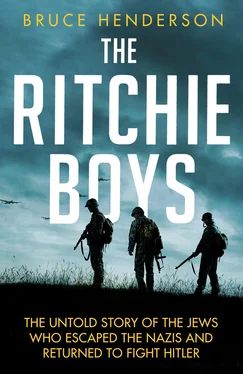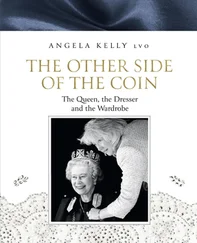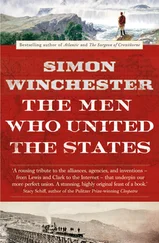To this day, the exploits and strategic importance of the Ritchie Boys are little known. They took part in every major battle and campaign of the war in Europe, collecting valuable tactical intelligence about enemy strength, troop movements, and defensive positions as well as enemy morale. In the course of the war, tens of thousands of newly captured Third Reich soldiers were interrogated by teams of these German Jewish soldiers. A classified postwar report by the army found that nearly 60 percent of the credible intelligence gathered in Europe came from Ritchie Boys. Yet there has been no publication of their operations or a complete roster of these men made public. As members of Military Intelligence, they were warned not to reveal their branch of the service or their training or duties during the war, and similar restrictions applied postwar to any documents, reports, or notes they may have retained. They held no reunions and were disinclined to join veterans’ organizations, as their German accents made them unwelcome in the usual circles of U.S. veterans. Their story is one of the last great untold sagas of World War II.
I am honored to tell the true story of these little-known heroes.
Bruce Henderson
Menlo Park, California
Loud banging at the front door jolted Martin Selling out of a sound sleep. It was shortly before sunrise, November 10, 1938.
Martin lived in Lehrberg, in southeast Germany; he and his relatives were the only Jews living among the thousand other residents of this tranquil agricultural village. Over the course of the previous day, the Nazis had carried out a series of brutal, coordinated attacks against Jews across Germany. But Martin wasn’t aware of that yet.
This widespread campaign of malevolence would forever become known as Kristallnacht, the “Night of Broken Glass,” so called because of the mounds of glass shards from broken windows that littered the streets after thousands of synagogues and Jewish-owned homes, businesses, and hospitals were looted and destroyed. The violence began after a teenage boy in Paris fatally shot a German embassy official—an act of retaliation, as his parents had been expelled from Germany, along with thousands of other Polish Jewish immigrants. Using the shooting in Paris as a pretext for a long-planned roundup of Jews, Nazi storm troopers took to the streets on the night of November 9.
Twenty-year-old Martin had recently returned to Lehrberg, his childhood home, from Munich, where he had been working as a tailor. Munich was the city in which Hitler rose to power and the national headquarters of the Nazi Party. Martin had seen Hitler numerous times; when his motorcade sped through the streets, everyone on the sidewalks was expected to stand at attention and snap a stiff right arm in a “Heil Hitler” salute. If Martin heard the Führer’s motorcade approaching, or even saw groups of marchers waving Nazi flags, he tried to be as inconspicuous as possible, slipping away or ducking into a side alley.
Earlier that year, Hitler had become aware that his motorcade regularly passed a large synagogue on its way to party headquarters. On the Führer’s orders, the congregation was given less than a day to remove its books and valuables; a few days later, the site was a newly paved parking lot. Martin’s boss, an older Jew, had finally seen enough. He fled to Italy, leaving Martin jobless and with no choice but to return home to Lehrberg.
The pounding on the front door did not stop but became louder and more menacing. By the time Martin reached the door it was in danger of being kicked in. He opened it to four storm troopers of the Sturmabteilung (SA), in matching brown shirts with red and black swastika armbands, who pushed him aside and rushed in, though at six foot two Martin towered over them.
Without giving a reason, the SA men searched the house—helping themselves to an expensive camera—then took Martin into custody along with his uncle, Julius Laub, who had been managing the family’s textile store next door since his sister, Ida—Martin’s widowed mother—passed away two years before. She had run the store following the death of Martin’s father from a heart attack fifteen years earlier. The SA men also arrested the housekeeper, the only other resident in the house. At the same time, other SA men were picking up Martin’s aunt Gitta and her three children, who lived nearby.
They were all driven five miles to an outdoor sports arena in the town of Ansbach, where they joined sixty other Jewish men, women, and children. The terrified group huddled in the bleachers for the rest of the icy night, shivering from fear and the chill of the blustery winds. Conversing softly with the others, Martin learned that the synagogue in Ansbach had been set ablaze, local Jewish homes vandalized, and Jewish men beaten. When Martin and some others asked the SA men what was going to happen next, they didn’t seem to know. They had only been ordered to arrest all the local Jews.
The following afternoon, at about 3 P.M., the women and children, as well as men over the age of fifty-five, were released without explanation. Martin, his uncle, and about fifteen other men remained in custody. They were marched to the local prison, an old, primitive structure, and locked up in a single cell. There was no running water or toilet—only a metal “honey bucket”—and the food was primitive and scarce. After two days in these cramped quarters, they were sent to Nuremberg, thirty miles away.
The Nuremberg district prison was filled nearly to capacity. Several hundred Sudeten Germans, ethnic Germans from Czechoslovakia, had also been arrested after raising opposition to Germany’s annexation of the Sudetenland, where three million ethnic Germans lived, two months earlier. The local Jews picked up during Kristallnacht—about a hundred in total from Nuremberg—were locked inside the prison gym, which had been furnished only with bare mattresses on the floor. Martin’s group joined them.
Most of the guards were older men accustomed to dealing with hardened criminals, not political prisoners, and they seemed overwhelmed by the crowded conditions. They did their duty and nothing more, which meant the prisoners were largely left alone. An inmate crew brought food from the kitchen to distribute among the prisoners, and at one point everyone was allowed to take a shower in a communal washroom, which had a row of multiple showerheads. The prisoners were let out of the locked gym in small groups for an hour a day; they could pace circles in the prison yard only after it had been cleared of Aryan prisoners so they would avoid contact with the Jews.
Within a week, some of the Jewish prisoners were released, Martin’s uncle among them. The decisions about who got out and who did not were utterly mysterious to Martin and everyone else. While some of the guards revealed that they had received the release orders from the local Gestapo, none of the feared secret police had shown up at the prison, and no prisoners had been questioned. By December 22—six weeks after Martin’s arrest—nine of his original group remained. On that day, guards thundered down the corridor, announcing that they were being moved to the Dachau concentration camp.
Martin, who was now in his own cell, felt as if he had been kicked in the stomach. He knew about the existence of Dachau, as did most Germans, but it was spoken about only in ominous whispers. Opened in an old World War I munitions factory near Munich in March 1933, Dachau was the first concentration camp established by the Nazis after they came to power. Schutzstaffel (SS) leader Heinrich Himmler had announced in the newspapers that Dachau would be utilized to incarcerate those who “threaten the security of the state.” During its first year, the camp held nearly five thousand prisoners, primarily German communists, Social Democrats, trade unionists, and other political opponents of the Nazis.
Читать дальше












